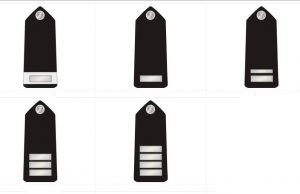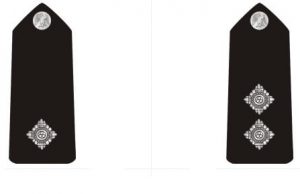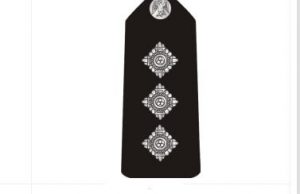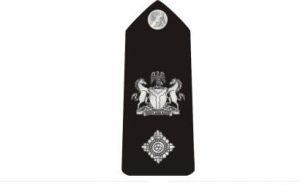profile/8585IMG_20201111_132439_3.jpg
Peddy

See The Rank Of Police Force And Their Symbol
~3.0 mins read
The following are the ranks of the Nigeria Police with their symbols arranged in ascending order of seniority. The rank of constable is the most junior and has no symbol so it is not inclusive in this article.
1. Corporal
Second most junior rank in the police force. It is the rank superior to the rank of Lance Corporal.Here is the batch representing the rank.
2. Sergeant
This is the 3rd most junior rank of the Police Force. It is superior to the first two and junior to Sergeant Major.
3. Sergeant Major
This is the fourth rank of the force and that is superior to Sergeant. It is the first rank that carries a symbol different from the first three. See the rank below.
4. Inspector
There are three ranks under the Inspector rank represented by the badges below. The first one indicates the Cadet Inspector, the second represents the unconfirmed Inspector, while the third badge indicates a confirmed Inspector. The fourth is for the principal Inspectors and the last is reserved for the Chief Inspectors.
5. Assistant Superintendent
There are two ranks under this rank. The first picture is for an Assistant Superintendent who is on probation while the second one is for the confirmed Assistant Superintendent. It is also the first rank of Cadet Officer cadre of the force.
6. Deputy Superintendent
The rank superior to Assistant Superintendent and next to the Superintendent rank. It is a senior rank in the force.
7. Superintendent
This is the fourth highest rank in the force and the second highest among the Superintendent after Chief Chief Superintendent.
8.Chief Superintendent
This is a senior officer rank which is the highest of the Superintendent and is the third highest rank in the force only junior to the Commissioners and Inspectors General.
9. Commissioner of Police
This is the second highest rank of the force. It is divided into three ranks whose rank symbols are shown below. The first badge is for an Assistant Commissioner, the second for an Assistant Commissioner the third for the commissioner himself. The Commissioner is the head of the Police in a state.
10. Inspector General
There are three ranks under this ranks and the highest in the Police Force as shown by the symbols below. The first badge is for Assistant Inspector General, the second is for deputy Inspectors General and the third is the Inspector General himself.
However, The Inspector General is the head of the Police Force and is appointed by the current President of Nigeria.
profile/8585IMG_20201111_132439_3.jpg
Peddy

Nigerian Currency's Used From Colonial Era Till Date
~4.5 mins read
1. Trade by barter (exchange of food items, animals, cloths etc): This system was adopted by people who lived in the same vicinity and it had to do with giving what you have in exchange for what you needed.
2. Cowries: Before the introduction of the bank notes and coins, cowries were the means of payment.
3. The Nigerian Shillings: This was issued between 1958 to 1959 but it is no longer in used in Nigeria today, but it is been used in places like Kenya and Uganda.
4. The Nigerian Pound: The Nigerian Pound was issued in the year 1967 but it is no longer in use today.
5. Another Five Shilling Note: In the year 1968, another five shilling note was issued as a war strategy.
6. One Pound Note: In the year 1968, the one pound Note was introduced again but in a different colour.
7. The 50 Kobo Note: In the year 1973, the 50 Kobo Note was introduced and it was later taken off the market in 1978.
8. The one Naira note: in the year 1973, the central bank of Nigeria introduced the one naria note.
9. The five Naira note: In 1973, the five naria note was also introduced and it bore the portrait of the first prime of Nigeria, Alhaji sir Abubakar Tafawa Balewa.
In 2007, the five naria note was changed from paper form to polymer notes and it is still in use today although it has lost its value.
10. The ten Naira note: The 10 naria note was issued also in 1973 and it bore the portrait of Dr Alvan Ikoku, he was a Politician and an educator.
The 10 naria note was changed to polymer notes in 2007 and it is still in use today.
11. The 20 Naira note: The 20 naria note was introduced in 1973 in paper form and it bore the portrait of General Murtala Mohammed a former Nigerian military head of state.
It was changed to polymer notes in 2007 and it's still in use today.
12. The 50 Naira note: Then in 1991, the 50naria note was the highest denomination when it was introduced in paper form.
In 2007, it was changed to polymer in 2007.
13. The 100 Naira note: The 100 naria was first issued in December 1999. It bore the portrait of chief obafemi Awolowo, a former premier of the western region.
On the 12th of November 2014, the 100 naria note was changed in commemoration of Nigeria's 100years existence.
14. The 200 Naira note: The 200 naria note was introduced in 2000 and it bore the Portrait if Alhaji Ahmadu Bello, the first premier of Northern Nigeria.
15. The 500 Naira note: The 500 naria note was introduced in 2001 and it bore the portrait of Dr Nnamdi Azikiwe, the first president of the federal republic of Nigeria.
16. The 1000 Naira note: The 1000 Naria note was introduced in 2005 and it's the highest denomination of this nation's currency. It bore the portrait ofAlhaji Aliyu Mai Borno and Dr. Clement Using who were the 1st and second indigenous governors of the central bank of Nigeria.
So guys how many of the previous notes do you remember? Please do leave a comment, like and share this article.
Advertisement

Link socials
Matches
Loading...







